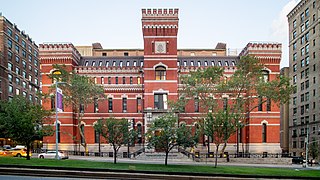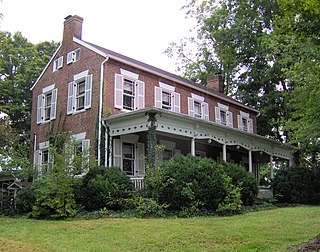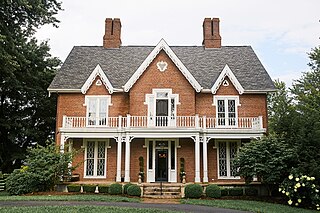
Sevierville is a city in and the county seat of Sevier County, Tennessee, located in Eastern Tennessee. The population was 14,807 at the 2010 United States Census and 17,117 according to the 2019 census estimate.

Vanderbilt Mansion National Historic Site is a historic house museum in Hyde Park, New York. It became a National Historic Landmark in 1940. It is owned and operated by the National Park Service.

The Charles Pinckney National Historic Site is a unit of the United States National Park Service, preserving a portion of Charles Pinckney's Snee Farm plantation and country retreat. The site is located at 1254 Long Point Road, Mount Pleasant, South Carolina. Pinckney (1757-1824) was a member of a prominent political family in South Carolina. He fought in the American Revolutionary War, was held for a period as prisoner in the North, and returned to the state in 1783. Pinckney served as a delegate to the constitutional convention where he contributed to drafting the United States Constitution.

The Seventh Regiment Armory, also known as Park Avenue Armory, is a historic National Guard armory building located at 643 Park Avenue in the Upper East Side neighborhood of Manhattan, New York City. The building is a brick and stone structure built in 1880 and designed in the Gothic Revival style by Charles Clinton.

The Alexander McMillan House is a historic home located at 7703 Strawberry Plains Pike in Knox County, Tennessee, United States. It was constructed in 1785 by Alexander McMillan (1749–1837), an early Knox County pioneer.

The Liberty Hall Museum, located in Union, Union County, New Jersey, United States, is an American historic site. Built in 1772 as a fourteen-room Georgian-style house, Liberty Hall stands today a fifty-room Victorian Italianate mansion. Liberty Hall has been home to many historical figures and was the home of William Livingston, the first Governor of New Jersey, who served from 1776 to 1790; United States Supreme Court Justice Henry Brockholst Livingston; the Kean political dynasty, including Susan Livingston Kean, widow of Continental Congress delegate John Kean, United States Senator and Congressman John Kean, and Captain John Kean, son of United States Senator Hamilton Fish Kean; and, in its first year of occupancy, future Treasury Secretary Alexander Hamilton. Liberty Hall has had visitors of such stature as George Washington, Martha Washington, Lewis Morris, Marquis de Lafayette, Elias Boudinot, and John Jay, the latter of whom was married there.

Rattle and Snap is a plantation estate at 1522 North Main Street in Mount Pleasant, Tennessee. The centerpiece of the estate is a mid-1840s mansion that is one of grandest expressions of the Greek Revival in Tennessee. It was designated a National Historic Landmark in 1971 for its architecture, and for its association with the Polk family, once one of eastern Tennessee's largest landowners. The house is privately owned, but may be viewed by appointment.

Sam Houston Schoolhouse State Historic Site is a single-room log cabin-style schoolhouse in Maryville, Tennessee, built in 1794. Sam Houston taught at the school as a young man, before the War of 1812.

Frascati is an early 19th-century Federal-style plantation house near Somerset in Orange County, Virginia. Frascati was the residence of Philip Pendleton Barbour, Associate Justice of the Supreme Court of the United States and statesman.

Wheatlands is an antebellum plantation in Sevier County, in the U.S. state of Tennessee. The plantation's surviving structures— which include the plantation house, a storage shed, and smokehouse— have been placed on the National Register of Historic Places. The plantation house has been called "the best example of a Federal-style building remaining in Sevier County."

The John Pope House, also known as Eastview, is a historic house in Burwood, Williamson County, Tennessee. It incorporates hall-parlor plan architecture and single pen architecture.

The Brattonsville Historic District is a historic district and unincorporated community in York County, South Carolina. It includes three homes built between 1776 and 1855 by the Brattons, a prominent family of York County. It was named to the National Register of Historic Places in 1971.

The David Havard House, also known as the Former Quarters of Lee and Bradford, is a historic home located near Valley Forge in Tredyffrin Township, Chester County, Pennsylvania. During the American Revolutionary War, it served as quarters for several of George Washington's senior officers.

Dixona is a historic house in Smith County, Tennessee, near Dixon Springs. It is one of the oldest homes in Middle Tennessee.

The Ladies Rest Room is a historic building in Lewisburg, Tennessee, that is listed on the National Register of Historic Places.

The Alexander Ewing House is a historic mansion in Nashville, Tennessee, U.S. The two-story plantation home was built in 1821 in the Federal architecture style for Alexander Ewing. It is constructed of brick with a stone foundation and a gable roof. Both the north and south side elevations feature a pair of chimneys connected by a parapet wall. The house has been listed on the National Register of Historic Places since November 25, 1980.

The Van Horne House is a historic building at 941 East Main Street near Bound Brook in Bridgewater Township, Somerset County, New Jersey. The house was built c. 1750 and also known as Phil's Hill, after its owner, Philip Van Horne. It served as the headquarters for American General Benjamin Lincoln in 1777, during the American Revolutionary War, in particular the Battle of Bound Brook. Later, it served as the headquarters for American General William Alexander, Lord Stirling during the second Middlebrook encampment (1778–79). The house, on the early-18th-century Old York Road that connected Philadelphia to New York City, was a New Jersey landmark during the war. Since 2002, the Heritage Trail Association has used the house as its headquarters, including an exhibit space. It was added to the National Register of Historic Places on March 8, 2002, for its locally significant Colonial Revival architecture from 1937 to 1944.

Wall Spring, also known as Elliott Springs, is a historic mansion on a farm in Gallatin, Tennessee, U.S.. It was a horse farm in the Antebellum Era.

The Turney-Hutchins House is a historic house in Hartsville, Tennessee. It was the home of two veterans of the American Revolutionary War. It is listed on the National Register of Historic Places.

Warrenwood Manor is a historic property located in Danville, Kentucky, USA. The manor was built in 1856 by Samuel and John Fourche Warren, sons of the Revolutionary War veteran and legislator William Warren. The Warren family moved several times before finally locating upon the present site. The property has been occupied by prominent owners including the Reed, Warren and Shelby families, in the order in which they are named. The architecture of the home includes diamond shaped window panes across the front, a wide hand carved door and window facings and massive enameled white mantels.



















